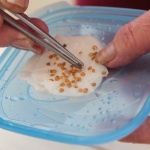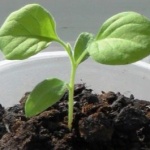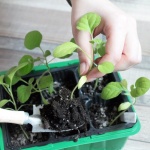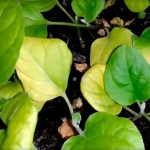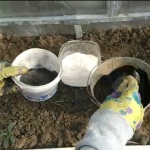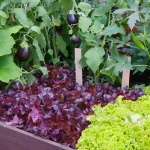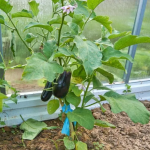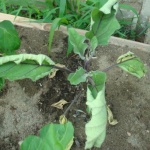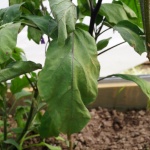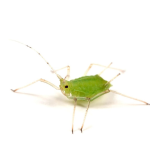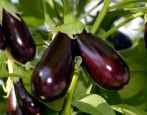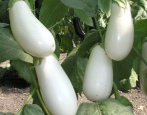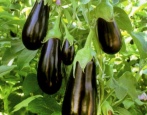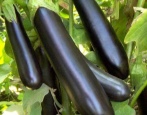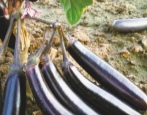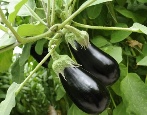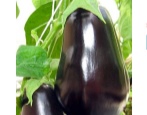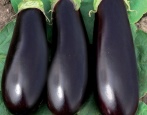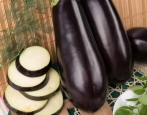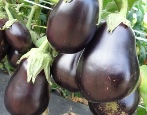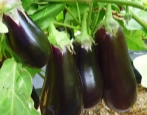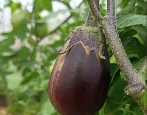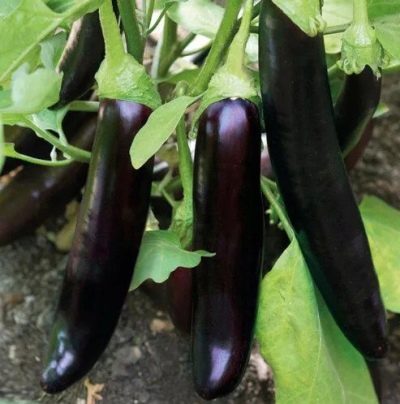
- Authors: Ognev V.V., Geraskina N.V.
- Name synonyms: Mesh Samuraiy
- Year of approval: 2015
- Growth type: medium-sized
- Bush height, cm: up to 60
- Fruit shape: elongated-clavate
- Fruit weight, g: 180-200
- Yield: high yielding
- Transportability: excellent
- Ripening terms: mid-season
Eggplant is considered one of the most whimsical crops to care for on a personal plot. The Samurai Sword variety is one of the few that can withstand temperature extremes, while delighting with a bountiful harvest.
Description of the variety
A relatively young variety, which was created in 2015 by domestic breeders Ognev V.V. and Geraskina N.V. For such a short time, it managed to fall in love with many vegetable growers for its pleasant taste and unusual appearance, reminiscent of a samurai blade.
Characteristics of the appearance of plants and fruits
The bushes grow to a medium height, up to a maximum of 60 cm. The plant is compact and semi-sprawling. The stem is strong, without anthocyanin color, with slight pubescence. Leaves of medium size are smooth, saturated green, with slightly wavy edges. The spines on the cups are not formed.
The elongated club-shaped fruits grow 20-22 cm in length and 6-7 cm in diameter. On average, the weight of an eggplant can reach 180-200 grams. At the stage of technical ripeness, vegetables are dark purple in color. The skin is glossy, the flesh is dense, whitish, with a small amount of seeds.
Purpose and taste
The eggplant tastes excellent, without bitterness. The purpose in cooking is universal. The vegetable can be fried, steamed, boiled, stewed. Use in preservation and freezing.
Ripening terms
Mid-season variety. From germination to harvesting, 110-120 days pass. Fruiting is long, until the onset of the first frost.
Yield
The culture is high-yielding. When grown under a film from 1 sq. m receive an average of 4.3 kg of fruit. Competent agricultural technology allows you to increase the yield several times. The harvested fruit perfectly tolerates transportation without loss.
Growing regions
The plant is specially designed for growing in temperate regions of the central regions. However, it can be planted almost throughout the country: in the Central Black Earth Region, the northern, North-West, Volgo-Vyatka, North Caucasian, Middle Volga, Nizhnevolzhsky, Ural, West Siberian, East Siberian, Far Eastern regions.
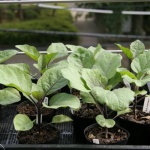
To get a tasty and bountiful eggplant crop, you must first grow strong and healthy seedlings. This culture is considered very capricious, therefore, you need to take care of seedlings when growing at home as correctly and carefully as possible.
Landing scheme
When planting, they adhere to the 70x40 cm scheme. The beds are positioned so that the plants do not interfere with each other, since eggplants need light, a sufficient amount of moisture and heat for successful development.
Growing and caring
Seed germination starts in mid-March. Eggplants do not tolerate transplanting well, so it is better to immediately plant them in separate containers in order to reduce trauma to the seedlings.
Before proceeding to sowing seeds, they are first soaked in a weak solution of potassium permanganate for half an hour.Next, the seed is spread in a damp cloth. The seeds begin to hatch after a few days. The germinated seeds are carefully buried in the nutritious soil mixture by 1 cm.
For good development, eggplants need a high temperature (+ 25 ... 27 degrees). After emergence, they need a lot of light, at least 12-14 hours. With a lack of natural light, additional ultraviolet lamps are installed.
When full-fledged 2 leaves appear on the seedlings, they begin to harden. During the day, the containers are placed in a bright place, at night they are placed in a cool place. When the seedlings reach a height of 15-20 cm, they are transferred to a permanent place. As a rule, in mid-May, the plant is planted in a greenhouse, at the end of May - in open ground.
The area for eggplant is chosen the most illuminated and protected from drafts. The place is prepared in advance. The soil is carefully dug up, weeds and roots are removed, mineral and organic fertilizers are applied. In the spring, the site is dug up again, and beds are formed into which the compost is placed.
The culture is drought-resistant, able to withstand short-term heat. In this case, watering should be regular. Due to the lack of moisture, the yield is significantly reduced. However, it is impossible to overmoisten the soil too much, this can lead to the development of fungal infections.
Plants are watered according to the following scheme. After being transferred to a permanent place, they are irrigated every 2 days. When the seedlings take root, the period between watering is increased to 1 time per week, until the beginning of flowering. With the onset of fruit set and fruiting, irrigate more often - every 4 days. Irrigation is best done with settled and warm water. Weeding and loosening of the soil are mandatory activities.
When growing this culture, you must not forget about the dressing, to which the Samurai Sword responds positively. For the first time, fertilizing is applied even before the seedlings are planted in the ground with liquid humus. Phosphorus and nitrogen are necessary for eggplant during the period of intensive fruit formation.
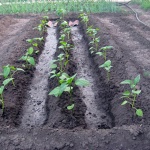
Planting eggplant is one of the most important stages in growing. When choosing a place for eggplants on your site, it is important to remember that this culture should be in warm soil, constantly illuminated by the sun. The plant is also very fond of spacious, open spaces, since its roots can grow over sufficient areas.
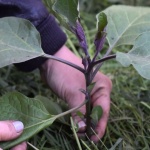
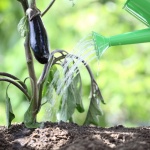
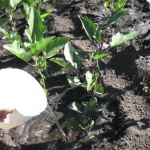
Disease and pest resistance
The samurai sword is practically not affected by pests such as the Colorado potato beetle and spider mites. But, unfortunately, the plant is relatively resistant to verticillium, fusarium. If you do not carry out preventive treatment of the bushes with a solution of potassium permanganate, then most often these diseases lead to the death of all plants.

Eggplant is one of the most demanding crops.For its successful cultivation, it is necessary to create optimal conditions, as well as to carry out prevention and fight against diseases and pests. Eggplant often infects both fungal and viral diseases. If treatment is not started on time, you can completely lose the crop.
